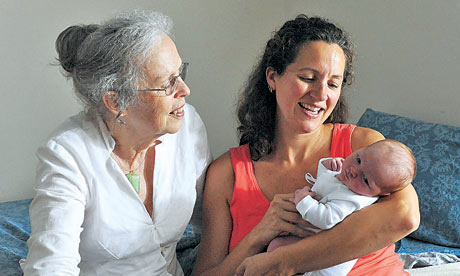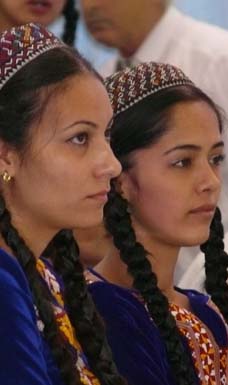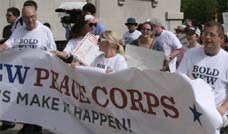
With her long, graying hair, often in braids, and her flashback '60s clothes, Ina May Gaskin isn't as glamorous as many other pregnancy and childbirth "experts" seen frequently on television and in the glossy parenting magazines. Instead, Gaskin looks like what she is: a hard-working, grandmotherly ex-hippie who still lives on the Farm, the legendary Tennessee commune that she and several hundred others founded in 1971. Yet despite her relative personal anonymity, Gaskin's influence on U.S. birthing culture has been profound. She's widely credited with having created the modern home-birth movement, as well as with almost single-handedly inspiring the renaissance of midwifery in the United States. And her 1976 book, "Spiritual Midwifery," a smallish trade paperback with a psychedelic cover design reminiscent of the Indian-print curtains on a '73 VW bus, is in its third printing, with more than a half-million copies sold.
From her Tennessee commune, Malaysia RPCV Ina May Gaskin almost single-handedly inspired the rebirth of midwifery in the United States
The midwife of modern midwifery
From her Tennessee commune, Ina May Gaskin almost single-handedly inspired the rebirth of midwifery in the United States.
BY KATIE ALLISON GRANJU
With her long, graying hair, often in braids, and her flashback '60s clothes, Ina May Gaskin isn't as glamorous as many other pregnancy and childbirth "experts" seen frequently on television and in the glossy parenting magazines. Instead, Gaskin looks like what she is: a hard-working, grandmotherly ex-hippie who still lives on the Farm, the legendary Tennessee commune that she and several hundred others founded in 1971. Yet despite her relative personal anonymity, Gaskin's influence on U.S. birthing culture has been profound. She's widely credited with having created the modern home-birth movement, as well as with almost single-handedly inspiring the renaissance of midwifery in the United States. And her 1976 book, "Spiritual Midwifery," a smallish trade paperback with a psychedelic cover design reminiscent of the Indian-print curtains on a '73 VW bus, is in its third printing, with more than a half-million copies sold.
"Ina May's contribution to the culture of childbirth in the U.S. has been enormous," says Robbie Davis-Floyd, Ph.D., a research fellow in the department of anthropology at the University of Texas and author of "Birth as an American Rite of Passage." "I have known for years that she is the most famous midwife in North America; now I can say without hesitation that she is also the most famous midwife in the world."
Although this sort of professional recognition from academics, physicians and researchers has become routine for Ina May Gaskin, it is somewhat unusual, considering that this "most famous midwife in the world" has neither a Ph.D. nor any formal medical training. Instead, Ina May Gaskin's road to prominence has been decidedly nontraditional.
The woman called "the mother of authentic midwifery" by Midwifery Today editor Jan Tritten began life 59 years ago in Marshalltown, Iowa, as Ina May Middleton, the daughter of what she describes as a "stable, Midwestern, Protestant family." She grew up a tomboy, wrestling with her brother, delivering newspapers and reading voraciously. Although Gaskin claims she never imagined she'd one day become a midwife -- planning instead to become an engineer -- she does remember checking out of the local library the early natural-childbirth classic "Childbirth Without Fear" by Grantly Dick-Read. Gaskin concedes that this was an unusual reading selection for a 16-year-old Iowan in 1956.
"Birth just always fascinated me," explains Gaskin. "As a teenager, I could always tell you every detail of the birth stories in the historical romances I read."
An excellent student, Gaskin graduated from high school in Marshalltown in 1958 and decided to turn her academic aspirations to English after being denied a scholarship to study any of the "men's subjects" she was interested in. Married at 19, Gaskin attended community college before transferring to the University of Iowa, where she earned her English degree. After graduation, she joined the Peace Corps with her husband and lived in Malaysia teaching English, later returning to the Midwest to obtain her master's in English from Northern Illinois University in 1967.
While she was a graduate student, Gaskin gave birth to her first baby in a hospital with an obstetrician in attendance. Despite her confidence that she could have the natural, unmedicated birth she wanted within the strictures of the medicalized childbirth system, her experience wasn't a pleasant one. "During birth at the hospital, I was left alone and treated like I had done something nasty. Then I was approached by a gang of masked attendants who came in the room and treated me like a ritual victim. They used forceps, and then I wasn't allowed to see my baby for 18 hours," remembers Gaskin.
Not long after becoming a mother, and radicalized by her own childbirth experience, 27-year-old Gaskin and her husband and daughter packed up and left for California -- the epicenter of the cultural universe in the late 1960s -- to, as Gaskin succinctly puts it, "become hippies."
There Gaskin's transformation from mother to mother of midwifery commenced in earnest. She began attending a lecture series given by the man she would later marry, San Francisco counterculture guru Stephen Gaskin, in which he spoke to groups of up to 2,000 young hippies on everything from religion to politics to sex. At these classes, Ina May Gaskin was exposed for the first time to a variety of women relating tales of their own unmedicated, outside-the-hospital births, an experience she found so affecting that to this day she remembers virtually every detail of the stories she heard a generation ago. For the first time, recalls Gaskin, she understood how beautiful a birth could be, given the right setting and support.
In 1970, a pregnant Ina May (who by this time was involved in what she describes as a "group family situation" with her husband and Stephen Gaskin and his then-wife) set off with approximately 250 other followers of Stephen Gaskin on what came to be known as "the Caravan" -- a five-month-long speaking tour across the United States. Traveling in colorful converted school buses, the group stopped in towns, cities and on college campuses so that Stephen Gaskin could lecture. One evening, while the buses were parked at Northwestern University, a pregnant woman from among the Caravan group went into labor. The sojourners had no money to pay doctors, and according to Ina May, their beliefs didn't allow them to accept welfare. Thus, with no physician in attendance, and with the woman's own husband catching the baby, she easily gave birth to a healthy boy. This turned out to be the first of 11 babies born on the buses during the Caravan.
"When each birth took place," writes Gaskin in "Spiritual Midwifery," "we all parked in a sort of protective formation around the bus in which the birth would take place, and everyone waited for the baby's first cry."
By the third birth within the group, Ina May Gaskin had emerged as a natural at attending births. Mothers began to request her presence during their labors and deliveries. She knew she was feeling a calling to become a midwife. But Gaskin still had had no medical training, until a Rhode Island obstetrician, having read in the local newspaper about the visiting hippies' bus births, took the trouble to visit the Caravan and offer her and a few other women some training in the essentials of midwifery.
"He gave [us] a hands-on seminar on how to recognize any complications we were likely to encounter, and what to do if we did, demonstrating how to stimulate a baby to breathe, what to do if the umbilical cord was wrapped tightly around the baby's neck, what to do if the mother hemorrhaged. He taught us sterile technique and provided us with some necessary medications and instruments, my first obstetrics textbook and gave us instructions on how to provide good prenatal care," remembers Gaskin.
With this rudimentary start to her education as a midwife, Ina May Gaskin was present for each of the next births that took place on the Caravan. Sadly, the 10th birth -- that of her own child -- ended with the death of her two-months-premature son, born on a bus in Grand Platte, Neb. At only 3 pounds, the baby lived a mere 12 hours and died in Gaskin's arms. Her grief over her loss only strengthened her resolve to continue helping other women to achieve empowering births with healthy babies.
Shortly after the Caravan returned to San Francisco, the group of 250 Gaskin-ites decided to establish a commune in the rolling farmland of middle Tennessee. Named the Farm, the commune flourished during the '70s and early '80s, eventually reaching a population peak of 1,500 in 1980. Since the early '80s the Farm population has held steady at more than 200 residents.
With a thriving community of men and women of childbearing age living on the Farm, pregnancy and childbirth became common occurrences. Soon after the commune's founding, and with the support of a sympathetic local doctor, Ina May and several other women established an on-site midwifery clinic to which Farm residents could come for prenatal and childbirth care. Births took place wherever the mother wished to be -- usually in her home. Women from outside the community were also able to hire the Farm's midwives as birth attendants at a cost of less than half that for OB care. Today, the majority of the 100 births a year the Farm midwives handle are of women living outside the community.
With the publication of "Spiritual Midwifery," in 1976, Ina May Gaskin's work on the Farm began to receive wider notice. A mix of first-person homebirth stories, black-and-white birth photography and information on caring for women in pregnancy and childbirth, the book laid out Gaskin's philosophy that birth is a spiritual event akin to making love, and that women could take back the power to give birth without excessive and unnecessary medical intervention. These were revolutionary ideas at a time when the ancient profession of direct-entry or "lay" midwifery -- in which midwives receive the majority of their training through apprenticeship with other skilled midwives rather than in medical or nursing school -- had all but died out in the United States under intense pressure from physicians' groups such as the American Medical Association and the American College of Obstetricians and Gynecologists.
Gaskin's book introduced an entire generation of young women to the possibility of homebirth and midwifery. Passed from mother to daughter and from friend to friend, the book's impact stretched far beyond its actual sales figures. Many of today's midwives and midwifery advocates report having discovered their career calling in the pages of "Spiritual Midwifery."
Susan Hodges, the president of Citizens for Midwifery, says of Gaskin's book: "I first heard of Ina May Gaskin when my Bradley Method childbirth educator loaned me her copy of 'Spiritual Midwifery' when I was pregnant the first time. This book had an enormous impact on me and changed the way I thought about childbirth."
Karen Lupa, who went on to become a certified nurse-midwife, remembers, "I was first exposed to 'Spiritual Midwifery' while riding on a train in the '70s. A fellow passenger had a torn-up copy that I got to read various pages of ... enough to see that it was way different from what I learned in nursing school. It seems like 'Spiritual Midwifery' has been such a milestone in the natural birth movement that it couldn't have quite happened without it."
As women read and talked about "Spiritual Midwifery," demand for midwifery care began to grow, and by the early 1980s, despite the fact that the practice was illegal in many states, the number of midwives in this country was again slowly on the rise. Awareness of midwifery in the United States has been increasing ever since: The American College of Nurse-Midwives reports that while only 6.14 percent of this country's total births are attended by midwives, preference for in-hospital, midwife-attended births in the United States grew from about 20,000 in 1975 to almost 239,090 in 1996. Currently, approximately 30,000 women each year give birth in planned homebirths, and there are now approximately 10,000 midwives, both direct-entry and nurse-midwives, practicing in this country -- still many fewer per capita than in other Western nations.
In addition to her writing, Ina May Gaskin's renown has spread through her clinical midwifery skills, developed entirely through independent study and apprenticeship with other midwives around the world. The statistics for Gaskin's midwifery practice, which has delivered more than 2,300 babies, tell the tale. In contrast to the national Cesarean rate of over 22 percent, the Farm's midwives have a rate of only 1.8 percent. And in 1992, a peer-reviewed study of the work of the Farm midwives in the Journal of the American Public Health Association compared over 1,700 planned, direct-entry, midwife-assisted home births with approximately 14,000 statistically matched hospital births. Only 2 percent of the women who gave birth at home experienced such interventions as forceps, vacuum extractors or C-sections, while 26 percent of those giving birth in the hospital encountered these outcomes.
Additionally, Gaskin is now credited with the development and growing use of the Gaskin Maneuver, a revolutionary approach to dealing with the life-threatening obstetrical complication known as "shoulder dystocia," in which a baby's shoulders become stuck in a laboring woman's birth canal. In collaboration with Dr. Joe Bruner, a professor at Vanderbilt University College of Medicine, the Gaskin Maneuver has now been written up in the May 1998 issue of the Journal of Reproductive Medicine, as well as presented at medical conferences. This marks an extraordinary achievement for a direct-entry midwife.
According to Robbie Davis-Floyd, Gaskin's ability to bring together the sometimes hostile opposing camps from the worlds of medicine and midwifery has been perhaps her greatest achievement. Ina May is "warm, funny, good-hearted, brilliant, politically savvy and aware -- a postmodern hippie who holds a very strong space for her alternative knowledge system yet moves with fluidity and ease in the professional, political and medical realms," notes Davis-Floyd.
As one of the founders and the current president of MANA -- the Midwives' Alliance of North America -- Gaskin has been at the forefront of legalizing and credentialing direct-entry midwifery while maintaining a "separate but equal" status with certified nurse-midwives. She has been instrumental in the development of the rigorous Certified Professional Midwife (CPM) certification process, which is rapidly gaining momentum within the midwifery community. And Gaskin also acts as publisher of Birth Gazette, a respected quarterly magazine for midwives and others, and conducts training for other midwives both at the Farm and around the world. Lastly, she has just written a book, tentatively titled "Ina May's New Birth Book: Breaking the Spell of Fear," which has attracted interest from several major publishers. Currently, however, she says that her favorite activity is spending time with her newly born grandaughter, born at home on the Farm with Gaskin and the baby's other grandmother -- also a Farm midwife -- in attendance. Gaskin says that if people take one message from her life's work it should be that birth is normal. "As a culture we really have to figure out how we got so afraid of birth and why, of all places in the world, we got rid of midwives here."
salon.com | June 1, 1999












